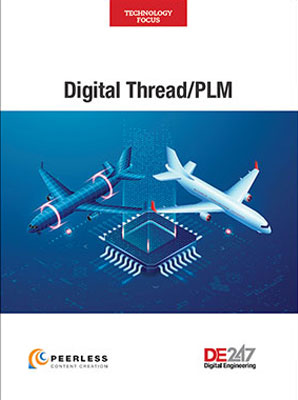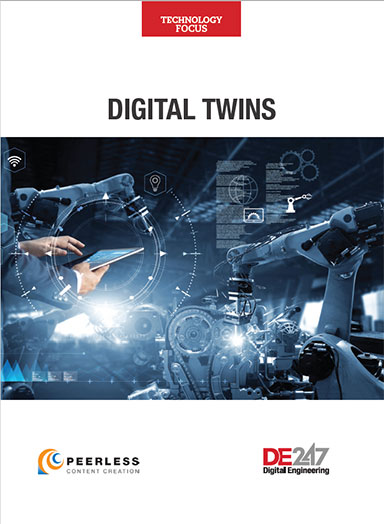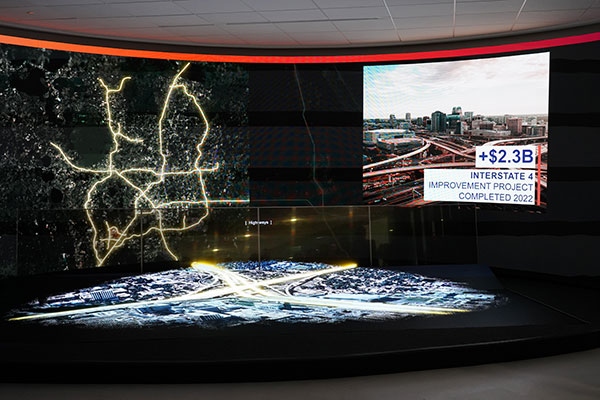
Based on its game engine, Unity offers users a way to connect to digital twins via lightweight devices or AR/VR headsets. Image courtesy of Unity.
January 30, 2024
Notable growth is expected in the digital twin market, at least until 2030, according to Grandview Research. The market analysis firm stated, “the global digital twin market size was estimated at U.S. $11.13 billion in 2022 and is projected to grow at a compound annual growth rate of 37.5% from 2023 to 2030.”
Experts are equally optimistic about this growth. “Digital twins are a rapidly growing field. One of the drivers is that people have assets, whether it’s buildings or factories. And a variety of industries need digital twins to drive efficiencies in their operations,” said Sven Boesen, director of industry solutions, Unity.
Also growing is the data associated with developing and maintaining digital twins, which are far greater than typical manufacturing data in size and complexity. Historically, manufacturers tend to rely on classic product lifecycle management (PLM), product data management (PDM) and enterprise resource management (ERP) systems to manage supplier info, compliance records, 3D CAD data, 2D drawings and bills of materials.. But digital twins add new layers, demanded by the data science involved.
“In addition to the digital model, sensor data from the physical asset is critical for maintaining a predictive digital twin,” says Sameer Kher, senior director of product development, Ansys. “Some of this sensor data is used to validate and calibrate the digital twin periodically while most of the data serves as input to the digital twin.”
Robust platforms to host the twins, visualize them and collaborate around them are emerging. For example, NVIDIA’s Omniverse. But digital twin data management remains uncharted territory for classic PLM, PDM and ERP vendors.
A Window of Insight
The key difference between a CAD model and a digital twin is the latter’s ability to mimic the real-world product’s behavior, according to Stuart McCutcheon, global vice president of New Product Development and Introduction & digital twin, Siemens Digital Industries Software. “Behavior means the ability to describe all aspects of the product—from kinematics, stress, thermal and fluid dynamics, acoustics, etc. All can be described by simulation of the product or the product within the environment.”
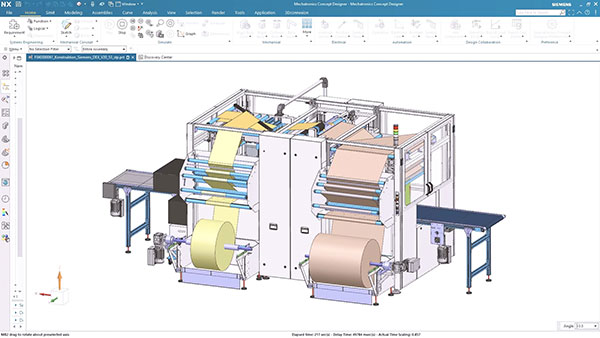
McCutcheon believes any 3D model viewer can potentially be a digital twin viewer. “We work with many viewers as part of our Siemens Xcelerator open architecture. All have different benefits. Our lightweight engineering format JT is an ISO open standard and has a viewer JT2Go that is very capable of viewing a digital twin within large scenes, as well as our design solution NX,” he says.
When NVIDIA launched its Omniverse, Siemens was one of the early manufacturing titans to strike up a partnership. In June 2022, the two announced their plans to “connect NVIDIA Omniverse and Siemens Xcelerator platforms to enable full-fidelity digital twins and connect software-defined AI systems from edge to cloud.”
McCutcheon explains, “For NVIDIA Omniverse, we are developing a 3D viewer component within our Siemens Xcelerator portfolio specifically for its high-fidelity real-time rendering.”
This may be a model other PLM and PDM merchants can follow to support future digital twin operators.
Reduced Order Models
Data is the lifeblood of digital twins. But it’s also a burden.
“A key challenge is that the volume and frequency of data will vary quite widely between different applications,” Kher points out. “For example, highly engineered equipment like bioreactors may have tons of sensors, but there will likely be only a few instances of the equipment itself. More high-volume products like pumps or compressors likely have a large number of instances but only a few physical sensors per instance. In general, when there is a lot of data needed, more processing (including executing the digital twin) will be done on the edge versus on the cloud.”
In search of a way to alleviate some of the data-management workload, some are taking a close look at reduced order models (ROMs). Classic simulation, part of making predictions with digital twins, demands full physics-based calculations of stress distribution, deflections, deformations and airflows. On the other hand, ROM use lets you bypass some or most of the physics-based calculation, and rely on a few parameters that disproportionately affect the performance of the design. This approach is much more suitable for the edge-side processing because edge devices typically have less local computing capacity.
“ROMs allow simulation to run faster—in some instances, even faster than real time,” says McCutcheon. “They might not always reach 100% accuracy, but with correlation, they can come close. The real advantage we see in speeding up simulation is, it can reduce compute needs.”
Once you have successfully developed a reliable ROM, you may be able to run a simulation with less data. But ironically, McCutcheon points out, “Producing an accurate ROM may take more data.”
McCutcheon says Siemens champions closed-loop digital twins: “Where sensors from the physical product and asset are used as input drivers to simulation models to correlate the simulation model and show real-time results of what is happening with the product.”
“ROMs certainly help reduce the need for data. For example, ROMs enable virtual sensors to augment physical sensors, requiring fewer physical sensors and thus lowering the data-management burden,” Kher says.
Kher was also a panelist in the November 2023 DE 24/7 roundtable titled, “Digital Twins: Who Needs Them? What Are They for.” The episode highlights manufacturers who stand to benefit the most from digital twins and the reliability of predictive twins.
CAD to AR/VR Pipeline via Unity
Widely known for its game engine, Unity has expanded its offerings to manufacturing. Equipped with real-time 3D rendering, kinematics and AR/VR streaming, Unity’s interactive environment is another choice for building and hosting digital twins.
“Historically Unity came about as a game engine that was able to provide high-performing apps on lightweight devices,” says Boesen. “This is one of the reasons many manufacturers are using Unity as a first choice. Unity does well where you need to process lots of 3D data on devices that are not powerful.”
Workstations with graphics processing units (GPUs) can easily handle the interactive rendering demanded by digital twins. Unity’s solution, on the other hand, can also accommodate lightweight devices, like tablets and smartphones, significantly broadening the potential user base for digital twins.
The data pipeline from CAD to Unity is usually through a plug-in like Pixyz, which involves some manual work.
“We also have Unity Cloud, which automates most of the work. Levels of details will automatically be created. CAD will be converted to tessellated formats ready for streaming,” Boesen says.
This is usually a critical step for those who wish to use AR/VR hardware to virtually inspect and analyze their digital twins.
For editing and composing 3D assets, Unity offers Unity Editor. It’s the environment where users may import scanned data—such as point-cloud data of a real factory, mesh models and models constructed from photogrammetry—and then connect it to live sensor feeds and asset management systems.
“You can certainly process and assemble these data locally, but the benefit of doing it in the cloud is [that] it’s ready for streaming from the cloud afterward,” says Boesen.
Many CAD assemblies and subassemblies have joint information, which defines the degrees of freedom possible. This usually reflects how the actual equipment functions. If such data is lost in the import process, manual recreation would be a daunting task.
“In the Unity import process, these joint data come across like the kinematics in game characters, like the virtual rigs that control their movements,” Boesen says.
The Unity Editor plug-in also enables data exchange with NVIDIA Omniverse by allowing users to read and write Universal Scene Description (USD) files, the common standard in Omniverse.
At its 2023 Unite user conference, Unity announced a new Unity Cloud, featuring Unity Asset Manager, Unity DevOps, centralized Team Administration, Editor integrations and an improved Dashboard UI [user interface], according to a company blog post.
Virtual Twins vs. Digital Twins
Known for its design, simulation and PLM offerings, Dassault Systèmes is also looking closely at the digital twin phenomenon. However, it prefers the term virtual twins, as seen in its online posts.
“Virtual twin experiences combine the science-based representation of the product, factory or company through modeling and simulation with the prediction brought by real-world data science. In other words, unlike a digital twin prototype that focuses on one specific object, virtual twin experiences let you visualize, model and simulate the entire environment of sophisticated experience. They facilitate sustainable business innovation across the full product lifecycle. The virtual twin is both the digital replica of the product itself and of its history and evolution,” says Karin Cudd, NETVIBES senior manager, Dassault Systèmes. Cudd felt a virtual twin platform also needs to include AI and machine learning (ML) algorithms for continuous improvements. “The combination of modeling and simulation enriched with data on a collaborative platform allows users to gain the best insights to make better informed decisions. It provides the confidence that their business decisions are based on data,” says Cudd.
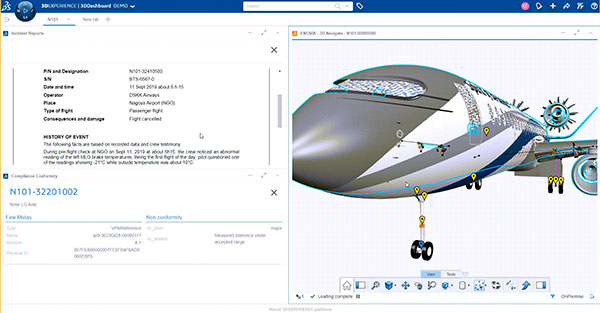
More than a decade ago, in 2012, Dassault Systèmes acquired NETVIBES, a French startup that offers a dashboard to manage brand reputation, online activities and communities. After the acquisition, the product gradually grew into a brand offering its own set of data science-driven product development solutions.
“This solution can bridge the information gap between the physical and virtual world by analyzing real- and virtual-world data together, empowering users with key insights to learn and make smarter decisions,” says Cudd. “AI and advanced analytics reveal critical insights into operational data to elevate modeling and simulation data, enabling virtual twins to react to complex variables while allowing unlimited what-if experimentation.”
As digital twin development and maintenance grows into a new discipline of its own, leading vendors from many relevant sectors—simulation, visualization and data management, to name but three—will likely spawn new variants of their products to address the emerging needs.
More Ansys Coverage
More Dassault Systemes Coverage

More NVIDIA Coverage
More Siemens Digital Industries Software Coverage
Subscribe to our FREE magazine, FREE email newsletters or both!
About the Author
Kenneth Wong is Digital Engineering’s resident blogger and senior editor. Email him at kennethwong@digitaleng.news or share your thoughts on this article at digitaleng.news/facebook.
Follow DE




